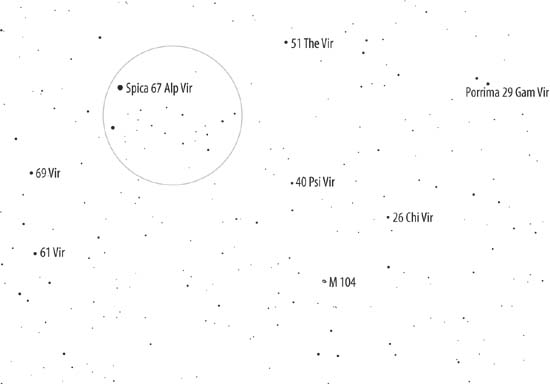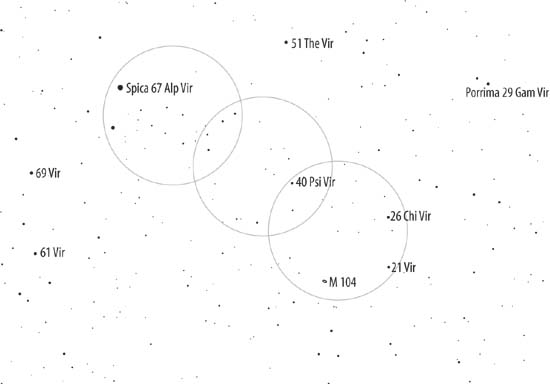Hack21.Learn to Star Hop
Hack 21. Learn to Star Hop
When a Telrad is not enough, find and focus on patterns, and then hop pattern by pattern to the target. Although the Telrad allows you to locate many objects with amazing speed [Hack #20], it's not a panacea. Some parts of the sky are simply devoid of the bright stars that you need to orient your scope with a Telrad. To find an object in those barren parts of the sky, you need to star hop. Star hopping is the process of locating an object by beginning at a bright "guidepost" star and then using your optical finder to follow a trail of dimmer stars until you arrive at the object. The secret to star hopping is to plan the hops so that each hop provides a distinct pattern of reasonably bright stars in the finder. When the pattern is right, you know that the finder is pointed exactly where you think it is, and you can then move the finder to locate the next pattern of stars.
You can plan a star hop using either printed charts or planetarium software on your computer. We much prefer using planetarium software because it lets us print out custom charts set to whatever limiting stellar magnitude [Hack #13] we want, and it prints finder circles directly on the charts. There are two ways to plan a star hop using printed charts. The first method, although it is more commonly used, is less desirable:
The following four figures show an example star hop from the first-magnitude star Spica in Virgo to the Sombrero Galaxy, M104. To begin the star hop, center Spica in your optical finder. Pivot the scope along the line from Spica to Porrima, offsetting a bit toward the constellation Corvus. When Spica is near the edge of the finder field, you'll see an arc of four bright (5th and 6th magnitude) stars on the opposite edge of the finder field, as shown in Figure 2-18. (This star hop sequence uses a RACI finder with a 5.5° field of view.) Figure 2-18. The first hop from Spica to M104
Continue pivoting the scope on the same line to put that arc of stars on the opposite edge of the finder field, as shown in Figure 2-19. The 5th magnitude star 40 Psi Vir appears in the field of view, as does an arc of three 6th magnitude stars near the edge of the field. Figure 2-19. The second hop from Spica to M104 Continue pivoting the scope on the same line until 40 Psi Vir is on the trailing edge of the field and the 5th magnitude stars 26 Chi Vir and 21 Vir appear on the leading edge of the field, as shown in Figure 2-20. M104 is now in the finder field of view, although at best it will show weakly in a 50mm or larger finder from a very dark site. Figure 2-20. The third hop from Spica to M104 Pivot the scope on the line from 26 Chi Vir to 21 Vir until 21 Vir is at the edge of the field. Note the equilateral triangle formed by three 6th magnitude stars, two of which are just outside the finder field in Figure 2-21. When you see that triangular pattern of stars, you've gone just slightly too far. Pivot the scope in the opposite direction until the two stars have just disappeared from the field of view, and M104 is centered in the finder (and the eyepiece). You can confirm the position by the position of the 6th magnitude stars HR4779 (visible here at 6:00) and HR4822 (at 8:00). For further confirmation, note the double star just below the center of the finder field. This 7th magnitude pair is separated by about 5.5 arcminutes, and is quite prominent in the finder. This star hop is a relatively easy examplein reality, most astronomers would simply use a Telrad to locate M104 geometrically from Spica and Porrimabut it illustrates the process. Rather than 5th and 6th magnitude stars, many star hops use 7th and even 8th magnitude stars. To find an object that's really out in the middle of nowhere, you may have to use 9th and 10th magnitude stars, which are at or beyond the limit of a 50mm finder. Figure 2-21. The fourth hop from Spica to M104 When that happens, you'll find yourself doing eyepiece star hopping, which is just what it sounds like. You use the optical finder to get as close as possible to the object, and then you begin using the main telescope to locate star patterns dimmer than those visible in the finder. For eyepiece star hopping, it's important to have a finder eyepiece with a wide field of view [Hack #48]. |
EAN: 2147483647
Pages: 112
